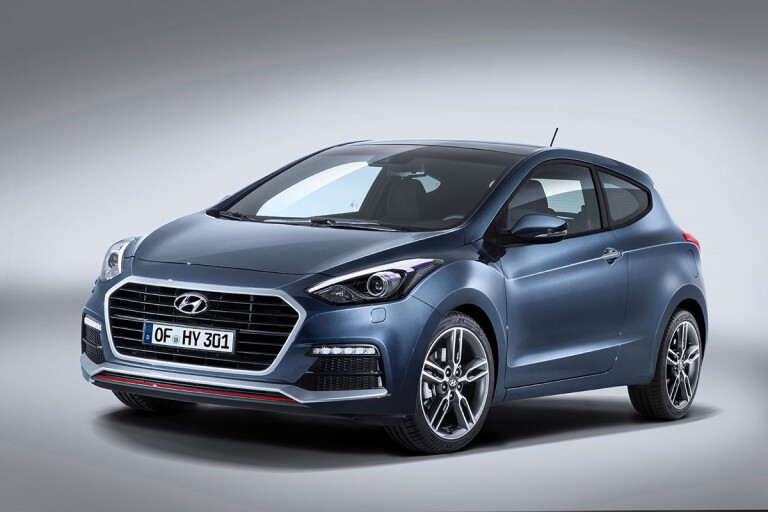
RESULTS
An astute performer that listens, but can’t get complacent. Renewed vigour to Hyundai, unlikely to let up in 2015 with important new models and updates likely to boost brand further. Reputation is also in good stead thanks to now-proven reliability and good after-sales support. But without ute, Hyundai is limited in how far it can go, with number two the best it can hope for in medium term.
Rank*: 4th
Sales*: 83,754 (+3.7%)
2014 sales forecast: 98,000
Wheels prediction for 2015: 3rd
*To end of October
HYUNDAI built its name as the cheap car company in the 1990s with the well priced, well styled and colourful Excel. It once accounted for more than 70 percent of the brand’s sales, with the rest made up of other relatively cheap models. Back in the mid-1990s the then fledgling Korean brand had more than 8 percent of the Australian market – predominantly on the back of small cars.
These days the brand’s market share hasn’t grown markedly – it’s currently at 9.1 percent – but its sales have, with expectations of almost 100,000 vehicles in 2014.
Helping it is the fact Hyundai has diversified its product portfolio to a range that now includes light, small, medium, sporty coupe, two SUVs and commercial vans – as well as the Genesis luxury car that’s just gone on sale. It’s the result of more than a decade of work to move away from selling cars predominantly on price, where profit is slim and sales dry up the minute another brand follows suit. Speaking of which, that’s what Chinese car makers have been dabbling with in recent years – and there will be more to come.
Hyundai clearly feels it’s turned the corner and people no longer see it as a cheap car company. The sales figures support the sentiment, with the Santa Fe a profitable success that has more buyers than cars, partly because it’s one of the few affordable seven-seat SUVs available with a diesel engine. It’s barged into a seven-seat SUV market once dominated by Toyota, Ford and Mazda. It’s also acclimatised some buyers to paying upwards of $50K for a Hyundai.
The i20 is now the closest thing to that original Excel, and accounts for just 15 percent of Hyundai’s sales, with the i30 and its small car sedan sibling, the Elantra, commanding the biggest share.
OPPORTUNITIES
HYUNDAI has aspirations to increase sales by 50 percent over the next few years, and 2015 is key to kicking that off.
First step is to replace the i20 entry-level hatch. Executives have crunched the numbers on the smaller i10, as well as the replacement for the i20, but exchange rates are not particularly favourable (the cars are sourced from Turkey).
It’s the i10 shaping to be the most likely candidate and, if it happens, it’ll arrive in the first half of the year.
The brand’s second-best seller, the ix35, is also due for replacement mid-year, bringing more mature styling that Hyundai hopes will arm it better against the CX-5s, RAV4s, Foresters and CR-Vs it scraps with.
The return of the Sonata (the previous model was sold here with limited success as the i45) also happens in February, likely leading to a rejig of the i40 lineup that it is close to on size.
There will also be facelifts for the Veloster coupe, Elantra hatch and smaller i30, each in the first half of the year, while the iMax (for people) and iLoad (for cargo) vans will get a tickle towards the end of the year.
CHALLENGES
THE Korean car maker is arguably the best placed to tackle the might of Toyota, but it lacks one key ingredient – a ute. It’s the only one of the top seven selling brands that doesn’t compete in a segment of the market that accounts for almost one in six sales. And executives are not expecting a trayback to pop off the boat any time soon (dealers would love one but despite internal number crunching there’s no approved program; something that would rely on enough global demand).
The brand could also do with a compact SUV to sit below the ix35, but the ix25 is for China only, with the only hope a production version of the style-led Intrado concept shown earlier this year.
Given the fragmentation of the small-car market – something likely to continue with the onslaught of small SUVs – that short-term lack of a compact SUV leaves Hyundai exposed at the lower end of the segment, which is where much of the growth potential slumbers.
There could be an internal threat from Kia, too. The sister company to Hyundai underperforms in Australia, something that hasn’t gone unnoticed at the brand’s South Korean HQ. With a former Hyundai exec now at the helm the brand is keen to kick more goals, many of which should come from the value end of the market – largely where Hyundai already plays.
In response, Hyundai is encouraging its 160-plus dealers to upgrade facilities in anticipation of higher volumes.
Hyundai may soon have room to move on pricing, though, with the soon-to-be-implemented free trade agreement with South Korea. Most of its models are sourced from there, allowing for about a three percent price reduction, or additional equipment for the same price.

COMMENTS